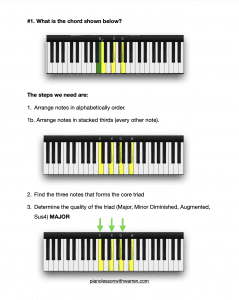Introduction:
Welcome back to another exciting piano lesson with Warren! If you’re new to the channel, I’m Warren McPherson, and today, we’re going to explore some valuable tips and tricks to elevate your chord-playing skills.
By “beefing up,” I mean making your chords sound more pronounced, modern, and professional – in other words, giving them a beefy, heavy, and substantial quality. These techniques are suitable for beginners and can instantly enhance your playing.
Just as a touch of salt and pepper can elevate your meal, these chord enhancements will elevate your piano playing. Let’s dive in and unlock the potential of your chords.
Section 1: The Basics
-
Exploring the Key of G Major: To begin, we’re going to work in the key of G Major. Understanding the diatonic chords in this key is essential. In G Major, we have the following diatonic chords:
- G major (I)
- A minor (II)
- B minor (III)
- C major (IV)
- D major (V)
- E minor (VI)
- F# diminished (VII)
-
Importance of the Number System: It’s crucial, especially for beginners, to familiarize yourself with the number system. Understanding the numeric relationships between chords in a key is fundamental for playing by ear.
Section 2: Adding the 9th to Major Chords
- Tip 1: Enhancing Major Chords with the 9th: One of the simplest yet effective ways to improve your major chords is to add the 9th. You don’t need to delve deep into theory; simply know that it sounds good. Adding the 9th is easy – it’s the note that is one whole step up from the root. For instance, in a G major chord, you can add the A (the 9th) to create a G add9 chord. This minor adjustment instantly makes your chords sound richer and more professional.
Section 3: Adding the 7th to Minor Chords
- Tip 2: Elevating Minor Chords with the 7th: Whenever you play a minor chord, adding the 7th can significantly enhance its depth and character. You can use a consistent hand position: root, fifth, and seventh in the left hand, and either the third and fifth or a full triad in the right hand.
Section 4: Tendency Tones and Minor Chords
- Tip 3: Tendency Tones for Minor Chords: Adding the 9th and 7th to minor chords can be done, but it requires some care. In most cases, it works well, but be attentive to your ear. The one exception to this rule is the 3rd chord in the key – the III (B minor). Adding the 9th can introduce a non-diatonic tone (C# in the key of G Major), which can be too aggressive. Use your ears to decide when this enhancement fits the song.
Section 5: Exploring the 4 Over 5 Chord
- Tip 4: Using 4 Over 5 Chord (4/5): You can often use a 4/5 chord as a substitute for a plain 5 chord or resolve it to the 5 for added depth. This chord consists of a 5 bass note with a 4 chord played in the right hand. It’s a versatile tool for creating tension and resolution in your chord progressions.
Section 6: Advanced Chord Extensions (For Intermediate and Beyond)
- Chord Extensions for Advanced Players: For more advanced players, you can explore chord extensions, passing chords, and reharmonization techniques to create intricate and engaging chord progressions. These techniques require a more nuanced approach and might not be suitable for every song, so use your judgment and let your ears guide you.
Conclusion: By incorporating these tips and tricks into your piano playing, you can quickly transition from a beginner to an intermediate level. It’s not necessary to dive deep into theory; instead, these tendencies and enhancements can elevate your chords instantly.
Practice and experiment with these techniques, and your piano playing will sound more polished, professional, and dynamic. Whether you’re new to the piano or an experienced player, there’s always room for growth and improvement.
Keep listening, keep practicing, and keep exploring – your musical journey is just beginning! If you’d like to learn more about these concepts, consider checking out our courses on pianolessonswithwarren.com.
And don’t forget to hit the subscribe button and the notification bell to stay updated with our weekly tutorials. If you have any questions or specific topics you’d like us to cover, please leave a comment below. Your feedback is essential for us. Happy playing!
Download The 7 Steps To Naming ANY Chord PDF For FREE
With this PDF, you NEVER HAVE TO GUESS what chord you’re playing.


